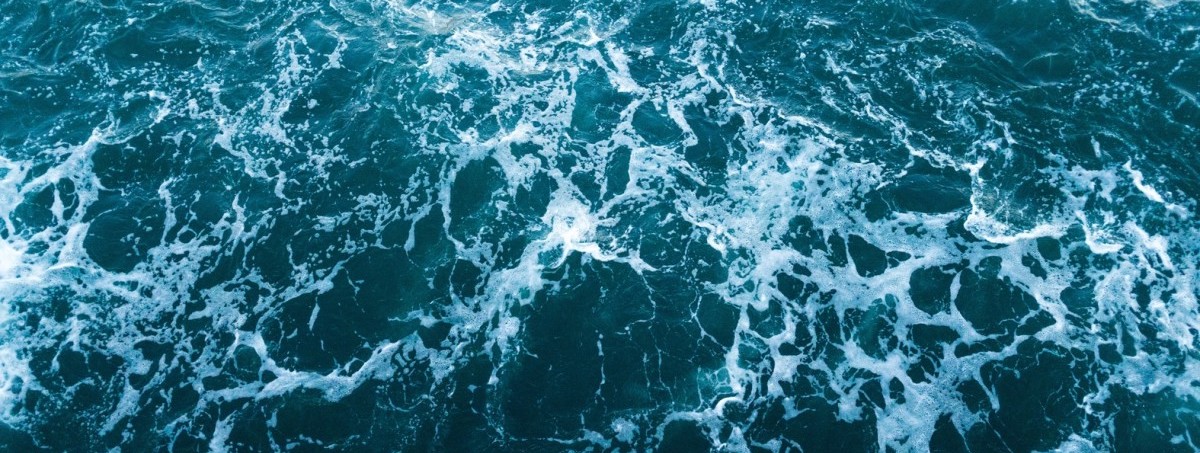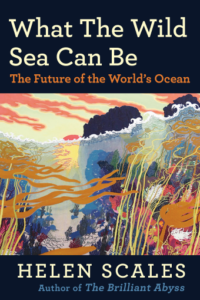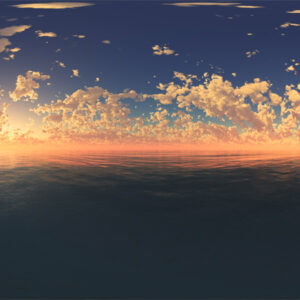
Taking the Long View: Why There Might Still Be Hope For the Earth’s Oceans
Helen Scales on How Best to Mitigate the Anthropocene’s Negative Impact on Marine Ecosystems
First, they were bright white dots moving in the distance between sea and sky. Then, as I reached the end of the land at the cliff’s edge, the gannets were everywhere. From eyeline to the waterline six hundred feet below, huge birds filled all the available space. They followed invisible contours through the air in every direction and on every horizontal plane. Somehow, silently, they knew to steer to avoid each other, their black-tipped wings never touching. Those not in flight were sitting on every piece of cliff with room to land. They were lined up on ledges, one bird deep, and the flatter patches of scree were studded in nests, always spaced a sharp beak’s biting distance apart.
If someone told me this was all the gannets there are, every last one of them, coming to nest on these very cliffs, I might easily have believed it. But other colonies exist on both sides of the Atlantic, some even bigger than this one, and all of them in places where the surrounding ocean contains enough prolific life and food to sustain so many parents and hungry chicks. Gannets dive from great heights to hunt beneath the surface, folding their wings back and piercing the water with their arrowlike heads. Air sacs under their skin, like a subdermal cloak of bubble wrap, protect their bodies from the impact of hundred-foot dives. The ammoniacal tang of guano that wafted from the colony told me about the ocean’s immense productivity and all the fish they’ve been catching.
I came to the gannetry at Hermaness, the northernmost headland on the northernmost inhabited island in Scotland, because I wanted to see an outrageous amount of healthy ocean life. Gannets are the North Atlantic’s biggest seabirds, with a six-foot wingspan and bodies more than three feet long. They don’t have the vivid blue or red webbed feet of their tropical cousins the boobies, but they have their own understated elegance. Mostly white, the adults have a dusting of peachy-yellow feathers on their neck and head, a long, tapering beak, and striking pale-blue eyes ringed in cobalt—a gleaming swipe of eyeshadow, like Marilyn Monroe in an Andy Warhol print. I had only ever seen an occasional, solitary gannet, usually from afar, and had long wondered what it would be like to see more. When I found out that they gather in enormous colonies in the Shetland Islands, I decided to see for myself tens of thousands of these huge seabirds at once. I wanted to stare and soak up the awe of it all and remind myself that places like this still exist.
A worse version of today’s ocean is not inevitable, but underestimating the scale of the problems and what needs doing to tackle them would be unwise.
That day, July 18, 2022, when gannets lured me to the farthest end of the British Isles, became the day when my outlook on the world changed. It marked the beginning of the United Kingdom’s first “red” extreme heat warning. Two days of national emergency had been declared because of a heatwave so severe it put human lives at risk, and people were told their daily routines would have to change. Advice for the worst-hit areas, including my hometown of Cambridge, was to stay indoors, shut and cover windows, and generally slow down. During the hottest day in the United Kingdom on record, runways and roads melted. Train services were suspended. People lay awake throughout the warmest night ever, when temperatures didn’t fall below seventy-seven degrees Fahrenheit. And Britain wasn’t alone. Extreme heat was engulfing western Europe. Portugal was suffering from a worsening drought, and parts of France and Spain were ablaze with wildfires.
Meanwhile, at Hermaness, a thousand miles north of my home, it was mild and pleasant, but it was strange and unsettling to know that everywhere to the south was far hotter. Missing that heatwave, I think, made it even more disturbing as I tried to imagine what was going on at home. That day, everything felt different. Until that moment, the climate crisis had remained an alarming but still distant threat to me. Suddenly, I realized that the world I had grown up in had gone, that normality had changed and the climate crisis had arrived.
I had booked the trip months earlier and escaped the horrifying heat just by chance. But I also happened to arrive in the middle of another disaster that was hitting northern Scotland far worse than anywhere else.
Standing at the cliff at Hermaness, looking at the scene through binoculars, I watched pairs of gannets sitting together, shaking their long beaks from side to side, and others sitting quietly on their own, waiting for a partner to return from foraging at sea. And there, visible between the nests, were the dead bodies of so many other gannets. More corpses were piled at the base of steep sections of cliff, presumably the ones that fell off their nests.
Avian flu had killed them all. For the first time since the disease appeared in a goose farm in China in 1996, the virus had mutated into a highly contagious and virulent strain and was ripping through populations of wild seabirds. There had been isolated outbreaks of less deadly variants in the wild before, but nothing like this. The epicenter in early summer 2022 was Scotland—in particular, the Shetland Islands.
By the time I visited Hermaness, I had already encountered many dead gannets and other seabirds, several on every beach across the islands, in varying states of decay. Some were little more than feathers ground into the sand. Some were skeletons, archaeopteryx-like, head flung back, and wings outstretched. And some gannets just lay there, intact and perfect, staring blue eyes open, wings folded back as if they had deliberately dived from the sky and landed without a mark on their bodies. Only at the gannet colony were the dead mixed in with living birds. Depending on where I let my gaze rest, this was either a desolate view of ecological breakdown or a stunning scene of natural wonder.
*
Planet Earth is in the throes of extreme environmental change, a transformation in which the dominant driving force is humanity. In the Anthropocene, the human-dominated epoch in which we’re all living, many of the fastest, most dramatic changes are taking place in the ocean.
Within just the past fifty years, as people have been overexploiting species, destroying habitats, and releasing pollutants, the total mass of vertebrate life in the ocean has halved. In that time, the ocean’s chances of being hit by lethal heatwaves, the kind that destroy kelp forests and coral reefs, have doubled. Every decade, the background noise levels in the ocean have also doubled, mirroring the growth in shipping, so that whales and other acoustic animals are having a harder time hearing each other. A plastic fog in the ocean is thickening and now comprises hundreds of trillions of particles. Since records began, the ocean has never been hotter. Sea levels are rising, and polar sea ice is shrinking. Seawater is becoming more acidic. Oxygen is ebbing away.
As humanity wades further into the Anthropocene ocean, changes are happening so quickly it can be hard to keep up with the streams of gloomy news. Scanning the science headlines, you might have come across recent news of a novel disease identified in seabirds caused by inflammation and scarring in their digestive tracts from the build-up of plastics that they swallow. Scientists have named this condition plasticosis. Or you might have caught word of how more marine species are being pushed towards extinction, with dugongs, abalone, and a type of Caribbean coral all recently added to the list of globally endangered species. Or that five out of the top ten commercially important fish populations in British seas are either overfished or depleted to critically low levels.
At the same time, people are making startling discoveries about what lives in the ocean and how this vast living system works. For instance, scientists recently discovered how northern elephant seals fall asleep while drifting down through the sea, like spiraling leaves, dreaming as they go, and sometimes take naps on the seabed. These enormous marine mammals breathe air, but they know they are in danger at the surface, where predators are more likely to attack, and so they only go to sleep underwater. Not long ago, another team of scientists tracked scalloped hammerhead sharks making regular dives into the twilight zone to search for prey and discovered that while they’re thousands of feet down, they hold their breath. These water-breathing fish know to close their gills to avoid cooling their circulating blood in the frigid deep water.
A previously unknown seagrass meadow, full of species like seahorses, scallops, and cuttlefish, was discovered just off the British coast of Cornwall. And in the Bahamas, tiger sharks fitted out with cameras helped discover the world’s largest seagrass meadow, extending around thirty-five thousand square miles, the size of the US state of Maine and more than twenty times bigger than the whole of Cornwall. This finding alone increased the known global area of seagrass habitat by almost half.
I’m often asked by audience members at public talks or by interviewers during radio shows whether I am hopeful for the future of the ocean. My common response is that it depends on which day you ask me and whether the last piece of news I heard or study I read was depressing or joyful. While I was watching the gannets of Hermaness, it dawned on me that I can hold both perspectives in my mind at once—my optimism and pessimism—and not let one push the other out.
There is no doubt that good and bad things are happening in the ocean, often pressed up tightly together, as the gannets showed me. Many discoveries that offer glorious and hopeful insights into ocean life are also tinged in trouble. In recent times, despite the growing threats of overfishing and warming seas, there are places where manta rays are flourishing; a population of at least a thousand of these magnificent, wide-winged cousins of sharks is swimming around in Komodo National Park in Indonesia; off the coast of Ecuador, a population was recently estimated to be the largest known in the world—by an order of magnitude—with more than twenty-two thousand mantas. And yet in both places, a portion of these animals show scars from collisions with boats and propellors, and many have been tangled in fishing nets or barbed with hooks.
Likewise, strands of hope run through even the most desolate ocean stories. Since I was in Shetland early in the avian flu outbreak, the situation has got far worse, and the virus has spread around the world. Millions of seabirds have died, the virus hitting more bird species in more locations than any previous outbreak. The virus has also jumped into wild mammals, killing foxes, otters, dolphins, and thousands of sea lions. Scientists are beginning to get a handle on how the virus is impacting wild populations, and in the thick of all the carnage, they have found a glimmer of resistance. The world’s largest colony of gannets is at Bass Rock in the Firth of Forth off the east coast of Scotland. This gannetry has suffered a huge die-off, but ornithologists have discovered some healthy-looking gannets with avian flu antibodies in their blood. Curiously, many of these survivors have jet-black eyes. It is not yet clear why this happens, or how the flu affects their vision, but for some reason when gannets fight off avian flu and survive, their pale-blue irises turn black.
*
In the messy midst of the changing ocean, so much has already been damaged and destroyed that discerning what the future may hold requires a careful balance of optimism and pessimism. A worse version of today’s ocean is not inevitable, but underestimating the scale of the problems and what needs doing to tackle them would be unwise. It is important to recognize that no place in the ocean is pristine and unspoiled anymore but also to appreciate that all is not lost; none of the ocean’s ecosystems and (almost) no species are entirely beyond hope. Many places in the ocean remain tremendously healthy and abundant, and there is still a great deal to fight for. This book, then, sets off with this mind-set on a journey through the Anthropocene ocean to find out what a better future could look like and what it might take to get there.
The starting point is the ocean’s distant past, which will root the stories that follow in the context of what happened over many millions of years, long before humans evolved. Keep that outlook in the back of your mind to help measure the changes unfolding in today’s ocean and grasp the magnitude of what is happening. For the centerpiece of each of the following chapters, I have picked living species and habitats that are responding in different ways to the Anthropocene. Many are familiar places and beloved animals, and I will dig deeper and uncover how their biology influences their chances of survival and dictates the course of action needed to help them thrive. We will meet species that are at the vanguard of a great modern remixing and conversion of the ocean, moving to new places and adapting to novel conditions, and that stand the greatest chances of surviving by themselves.
We will also encounter a suite of species whose glory is already fading fast, the ones that will be the hardest to save and will require the most urgent action. These animals are frantically imperiled by the biggest threats to ocean life and could be the first to succumb in turn to heating seas, overfishing, and pollution. Among them are the polar animals that are disastrously sensitive to rising temperatures and cannot persist without the coldest, frozen seas; the species that grow sedately and to such grand old ages that their exploited populations cannot keep up and replace themselves fast enough; and the apex predators that balance precariously at the top of food chains, where their bodies soak up toxins from the contaminated seas. Together they pose a great challenge but not a hopeless one, of how to reverse their bad fortunes, and they serve as a warning of worse problems that need to be avoided elsewhere in the world.
Ocean wildlife has a tremendous capacity to regenerate and recover from dreadful losses and depletion. Often all that is needed is for the exploitation, destruction, and pollution to stop—a great deal of optimism about the ocean comes from this possibility. Even what seemed to be irredeemable catastrophes have been turned around, including some involving high-priced luxury fish and neglected areas of seabed.
Sometimes the recovery process needs a helping hand to kick-start natural cycles and restore balance. And some habitats face such big problems they will likely require far more deliberate steering and coaxing through the vicissitudes of the Anthropocene ocean. Scientists and conservationists are already working to engineer futureproof species and habitats that can withstand the continuing changes. Their ambitions generally are not to return the ocean to the way it was before humanity began inflicting so many troubles but rather to reach towards a resilient version of the ocean that is still healthy and abundant and, in key ways, different and new—not a rewinding that could ultimately fail but a rewilding that will last.
No matter where you live and what you do, even if you have never seen the sea in real life, you would not exist—none of us would—without the ocean.
Together, ocean dwellers and their habitats have a lot to tell us about how the Anthropocene ocean is run through with inequalities. By no means is everything and everyone in the same boat. It is clear that some habitats and wild species—and people too—are already shaping up to be winners and some to be losers in the changing ocean. A critical part of a better future will be to find ways to undo inequalities and build an ocean that is just and fair and that benefits as many people and the greatest portion of nature as possible.
*
The future of the ocean matters to everyone. No matter where you live and what you do, even if you have never seen the sea in real life, you would not exist—none of us would—without the ocean. When astronomers examine other planets for signs of life, the key feature they search for is liquid water. Here on Earth, the ocean is where life began billions of years ago, and it is what has kept the planet alive ever since. Seawater covers seven-tenths of the planetary surface and plunges to many miles deep, and in its enormity absorbs huge amounts of heat beating down from the sun. Restless ocean currents swirl heat around the globe, preventing the tropics from scorching and supporting the mild mid-latitudes where many people live. The ocean is a rainmaker, providing most of the water that evaporates and falls on land. It generates weather systems and influences the climate we all experience in our daily lives.
The ocean makes the earth habitable not just by the physical presence of water but by the presence of life itself. Half the oxygen we breathe is made by multitudes of minute sun-fixing organisms, the phytoplankton that float through the seas. Phytoplankton also play their part in regulating the climate. They make clouds, which reflect the sun’s heat, by releasing particles into the atmosphere that cause water vapor to condense into droplets. Ocean life also mitigates the climate crisis by removing at least a quarter of humanity’s carbon emissions from the atmosphere. Phytoplankton absorb carbon dioxide and, when they die, create flurries of organic particles, called marine snow, which settle into the deep. A myriad of other life forms are critical in this drawdown of carbon, from underwater forests and meadows to giant whales and their plankton-fertilizing feces, and the trillions of glittering fish, called myctophids, that migrate each day between the sea surface and the shadowy twilight zone thousands of feet down.
The species and habitats discussed in this book are all vital parts of this life-giving system. They are sentinels of the rapid changes already underway in the Anthropocene ocean, and they forewarn of greater changes to come. In the coming pages, I will focus on what could happen in the next few years and decades, with the end of the century out there on the horizon. I picked this timeframe for a few reasons. On a practical level, 2100 is commonly the date at which scientific models and predictions aim, and so there are many studies that consider what the ocean will be like by then. We will all experience changes unfolding in the next years and decades, as will many of the people we know and care about. And if you think 2100 feels far off, remember that many children born today should still be alive to see the turn of the twenty-second century.
Crucially, the next few years are when decisions made will determine —one way or another—how the next phase of the Anthropocene ocean plays out for a considerable stretch of time to come. Right now, there are choices to be made, but the window of opportunity to meaningfully act is closing. Soon the ocean will reach a point when it heads down a certain path, and it will become harder and harder to change course.
Experts predict that carbon emissions must peak by 2025, at the latest, followed by sharp global reductions, if there is to be any chance of keeping global heating to within 1.5 degrees Celsius and avoiding the worst-case scenarios for people and the planet. While that target is looking less likely as the present decade wears on and emissions keep climbing, the Intergovernmental Panel on Climate Change (IPCC) has laid out a road map for how those emissions reductions could happen, underscoring the fact that the necessary technologies and solutions already exist. The most promising options are solar and wind energy, as well as preserving intact forests and other carbon-rich habitats, including in the seas.
Exploring the future of the ocean demands a fair amount of mental time travel, both backwards and forwards. The trick to navigating these waters will be to keep a sense of perspective (the ocean has always changed), to not go it alone (share these stories and ideas, talk about them so more people will know what is happening), and to make sure along the way to keep seeing the glory and feeling wonderment in the ocean. I hope this book will offer an antidote to the rising tide of eco-anxiety and fears for the future of the planet. Turn that fear into commitment and initiative. What matters most now is to not look away in anguish but to confront the problems and to know how bad things are and understand why they got this way, while at the same time wanting and hoping for the future ocean to be better.
__________________________________

From What the Wild Sea Can Be: The Future of the World’s Ocean by Helen Scales. Copyright © 2024. Available from Atlantic Monthly Press, an imprint of Grove Atlantic.
Helen Scales
Helen Scales, PhD, is a marine biologist, writer, and broadcaster. She is the author of many books about the ocean including The Brilliant Abyss and Spirals in Time, and the children’s books What a Shell Can Tell and Scientists in the Wild. She writes for National Geographic Magazine, the Guardian, and New Scientist, among others. She teaches at Cambridge University, is a storytelling ambassador for the Save Our Seas Foundation, and science advisor for the marine conservation charity Sea Changers. Helen divides her time between Cambridge, England, and the wild Atlantic coast of France.












